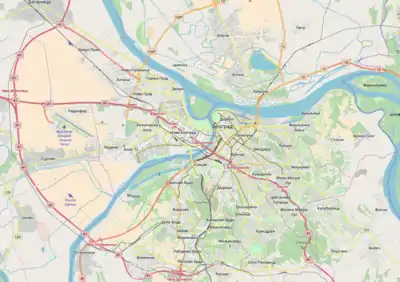Veliki Mokri Lug
Veliki Mokri Lug (Serbian Cyrillic: Велики Мокри Луг) is an urban neighbourhood of Belgrade, the capital of Serbia. It is located in Belgrade's municipality of Zvezdara.
Veliki Mokri Lug
Велики Мокри Луг | |
|---|---|
 Church of Saint Hieromartyr Kyriaki | |
 Veliki Mokri Lug Location within Belgrade | |
| Coordinates: 44°46′N 20°32′E | |
| Country | |
| Region | |
| Municipality | Zvezdara |
| Area | |
| • Total | 6.06 km2 (2.34 sq mi) |
| Time zone | UTC+1 (CET) |
| • Summer (DST) | UTC+2 (CEST) |
| Area code | +381(0)11 |
| Car plates | BG |
Location
Veliki Mokri Lug is the southernmost neighborhood of the municipality of Zvezdara, located on the right side of the Highway Belgrade–Niš. Surrounding area is still largely unurbanized, but it makes continuous built up area with several other neighborhoods, mostly along roads: Kaluđerica on the west, Mali Mokri Lug on the north, Kumodraž on the south and Padina and Medaković III, through Cvetanova Ćuprija.
Geography
Veiki Mokri Lug is located east of the Kumodraž field, on two hills, Mokroluško Brdo (234 meters) on the west and Stražarska Kosa, on the south. The settlement developed in the headwaters area of Mokroluški Potok, a right tributary to the Sava river, which flows between slopes of these two hills. The area is generally rich in springs and wells, which is obvious from many of the settlement's toponyms (streets like Petko's well, Miloš' well, Mitke's well, Little spring, Buljubaša's waters, Creek street) so as from its own name (veliki mokri lug is Serbian for "large wet grove" as opposed to Mali Mokri Lug, "little wet grove").
History and population
During the Roman period, the Romans built an aqueduct to conduct water from the hill on which the modern Veliki Mokri Lug is located. At some point it was joining the aqueduct from the nearby Kumodraž Hill, and the water was further conducted to the castrum of Singidunum, predecessor of modern Belgrade. Natural inclination of two hills was used for the water to flow all the way to the city.[1]
Until the 1970s, Veliki Mokri Lug was a separate village and a suburban settlement of Belgrade. With the massive administrative reorganization of the Belgrade City limits after the 1971 population census, entire eastern and southern string of more or less urbanized suburbs (Višnjica, Mirijevo, Mali Mokri Lug, Veliki Mokri Lug, Selo Rakovica, Jajinci, Kijevo, Kneževac, Resnik, Železnik, Žarkovo) were administratively annexed to the Belgrade City proper (uža teritorija grada), turning from the separate settlements into the "local communities" (mesna zajednica), sub-municipal administrative unit. Population of Veliki Mokri Lug by the official censuses:
- 1921 - 1,563
- 1971 - 6,753
- 2002 - 6,376 (as part of Belgrade)
Characteristics
Unlike majority of former suburbs and now neighborhoods on the outskirts of Belgrade, Veliki Mokri Lug kept mainly rural features, which resulted in population stagnation, while some neighboring settlements expanded significantly (Mali Mokri Lug, Kumodraž, Kaluđerica).
A motion for building the church in the neighborhood originated in 1988, and the construction began in 1990. It was consecrated in 1998 and dedicated to the Saint Hieromartyr Kyriaki, but remained unfinished. Some works were completed later, like the floor made of ceramic granite, but it remained unpainted and without iconostasis.[2]
Cvetanova Ćuprija
Cvetanova Ćuprija (Serbian Cyrillic: Цветанова ћуприја) is a 3 kilometers long street which connects Veliki Mokri Lug and Medaković III and a sub-neighborhood of Veliki Mokri Lug developing around it. It goes through the entire western section of the neighborhood, but the term is mostly applied to the previously empty are along the street between Veliki Mokri Lug and Belgrade, which is becoming more and more urbaznied since the early 2000s.
References
- Branka Jakšić (24 September 2017). "Pogled s neba i podzemne avanture" [View from the sky and underground adventures]. Politika (in Serbian).
- Aleksandra Kurteš (21 July 2020). Обележена слава цркве у Великом мокром лугу [Feast day of the church in Veliki Mokri Lug]. Politika (in Serbian). p. 14.